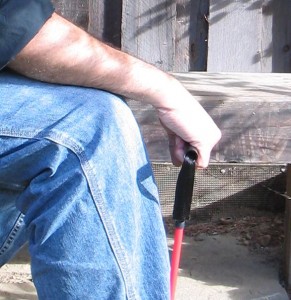Tennis elbow, also known as “lateral epicondylitis,” often affects active adults between the ages of 30 and 60 years, and causes pain on the outside of the elbow joint where the forearm meets the elbow. Internally, tennis elbow pain is localized where the muscles of the forearm merge into tendons and attach to end of the upper arm bone. A patient with tennis elbow will typically feel pain upon extending (unbending) the wrist (think of the wrist motion required to rev a motorcycle). As an aid to evaluation, a therapist can reproduce the pain by resisting the patient’s wrist motion. Sometimes tennis elbow can be so painful that the patient cannot raise his or her hand, even when no resistance is applied.
Although the condition is known by two names, neither is very accurate. You don’t have to play tennis to get tennis elbow! In addition to the high tensile stresses of the backhand tennis stroke, any other activity involving a firm grip, such as using a hammer or screwdriver, or heavy lifting, such as lifting suitcases away from the body with the palm facing the ground, can cause tennis elbow. And the “-itis” suffix of the name “lateral epicondylitis” signifies that the condition is characterized by inflammation, which is not the case. Factors normally associated with inflammation, such as certain white blood cells, cytokines, and chemokines, are not found at the site of the lateral epicondyle of the elbow. What surgeons do find, however, upon opening and examining an affected elbow, is disorganized connective tissue in the form of a characteristic yellow-brown scar. By contrast, healthy tendon tissue is glistening white and is composed of cells organized in neat rows along the axis of tension between the muscles of the forearm and the lateral epicondyle of the elbow.
Palliative measures for tennis elbow include rest and anti-inflammatory medication. Tennis elbow patients are also sometimes instructed to use a tight band around the upper forearm to help rest the painful area and protect it from damaging tensile loads. Although these measures are effective at reducing pain while they are used, they rarely result in full recovery, because they do not restore proper connective tissue alignment.
Fortunately, there are more effective measures. Twenty years ago, exercise physiologists discovered that eccentric exercise is a necessary component of rehabilitation from tendinitis. Eccentric exercise occurs when a muscle generates tension as it is lengthening. For instance, when you place a coffee cup down on a table, you are performing eccentric exercise: your biceps muscles must lengthen in a controlled manner to lower your forearm and place the cup down gently. You may think of eccentric exercise as the braking force needed to slow down the motion. The opposite of eccentric exercise is concentric exercise, which involves active muscle shortening.
Although the exact way in which eccentric exercise improves tendinitis is not known, researchers have discovered that muscle elasticity is a key feature of eccentric muscle contraction, and that eccentric exercise increases muscle elasticity. The leading hypothesis is that muscle tissues that have been made elastic by eccentric exercise effectively distribute and absorb forces that would otherwise lead to fraying of the tendon, formation of disorganized scar tissue, and tennis elbow pain.
At Physical Therapy of Los Gatos, treatment for tennis elbow begins with a thorough evaluation of the problem and a discussion of the patient’s rehabilitation goals. Movements associated with the activities that cause tennis elbow pain must be identified and analyzed. If the patient began having tennis elbow pain after playing tennis on rainy days, perhaps he or she needs only a short course of treatment and to stop hitting wet, heavy tennis balls. In other cases, we may find that improper use or involvement of the neck, shoulder, or wrist during sports or other activities has caused excessive loading of the elbow. In these cases, therapy includes instruction and retraining to balance the physical forces required for the chosen activity correctly.
 However, regardless of the other required elements of effective treatment, rehabilitation of tennis elbow will include progressive, eccentric muscle training. Eccentric muscle rehabilitation involves using wrist motion to lower a weight over the edge of a table while the forearm is supported. The patient uses his or her forearm muscles to raise the weight and then lower the weight in a controlled manner. The greatest eccentric muscle force occurs when the patient changes the weight’s direction of motion from downward to upward. Therefore, the amount of weight and the speed at which the weight is moved downward and upward can be varied to increase or decrease the intensity of training. As training progresses, the amount of weight and the speed of weighted movements are both increased. Effective eccentric muscle rehabilitation can also be accomplished using elastic resistance bands.
However, regardless of the other required elements of effective treatment, rehabilitation of tennis elbow will include progressive, eccentric muscle training. Eccentric muscle rehabilitation involves using wrist motion to lower a weight over the edge of a table while the forearm is supported. The patient uses his or her forearm muscles to raise the weight and then lower the weight in a controlled manner. The greatest eccentric muscle force occurs when the patient changes the weight’s direction of motion from downward to upward. Therefore, the amount of weight and the speed at which the weight is moved downward and upward can be varied to increase or decrease the intensity of training. As training progresses, the amount of weight and the speed of weighted movements are both increased. Effective eccentric muscle rehabilitation can also be accomplished using elastic resistance bands.
 When going over the instructions for eccentric muscle training, patients might be surprised to hear that their tennis elbow pain should increase towards the end of each exercise session. This is a case where “no pain, no gain” applies. Insufficient loading of the tendon (inadequate intensity) or loading along the wrong axis, will delay recovery.
When going over the instructions for eccentric muscle training, patients might be surprised to hear that their tennis elbow pain should increase towards the end of each exercise session. This is a case where “no pain, no gain” applies. Insufficient loading of the tendon (inadequate intensity) or loading along the wrong axis, will delay recovery.
Progressive, eccentric muscle training is the only type of exercise known to increase muscle elasticity and tendon strength and is the process by which disorganized connective tissues associated with tennis elbow pain are remodeled to become functional once again. In the treatment of tennis elbow, progressive eccentric muscle training as prescribed by a qualified physical therapist is a reliable and effective means of achieving specific recovery goals. The precise method, intensity, frequency, and duration of eccentric muscle training must match the recovery goals of each patient, allowing the tennis player to return to playing tennis and getting the carpenter back to work swinging a hammer without pain.

Comments on this entry are closed.